Training Program for APPF Member Countries: Internet & Web Development
VerifiedAdded on 2021/08/10
|41
|13448
|119
Report
AI Summary
This report presents a comprehensive training program designed for the APPF member countries, focusing on Internet and web page development. It begins with an introduction to the Internet, World Wide Web (WWW), and e-mail, detailing how to access the internet, including interface options like fiber optics, and addresses common misconceptions. The program then delves into web page development, covering basic and intermediate HTML, including document creation, HTML commands, text formatting, hypertext structures, tables, references, and incorporating various elements like images and audio. It also provides a guide to URL forms and style, including recommendations on information presentation, search optimization, and effective HTML practices. Furthermore, the report offers practical tips for web page design, such as image optimization and status line messages, providing a holistic guide to web development concepts and techniques.
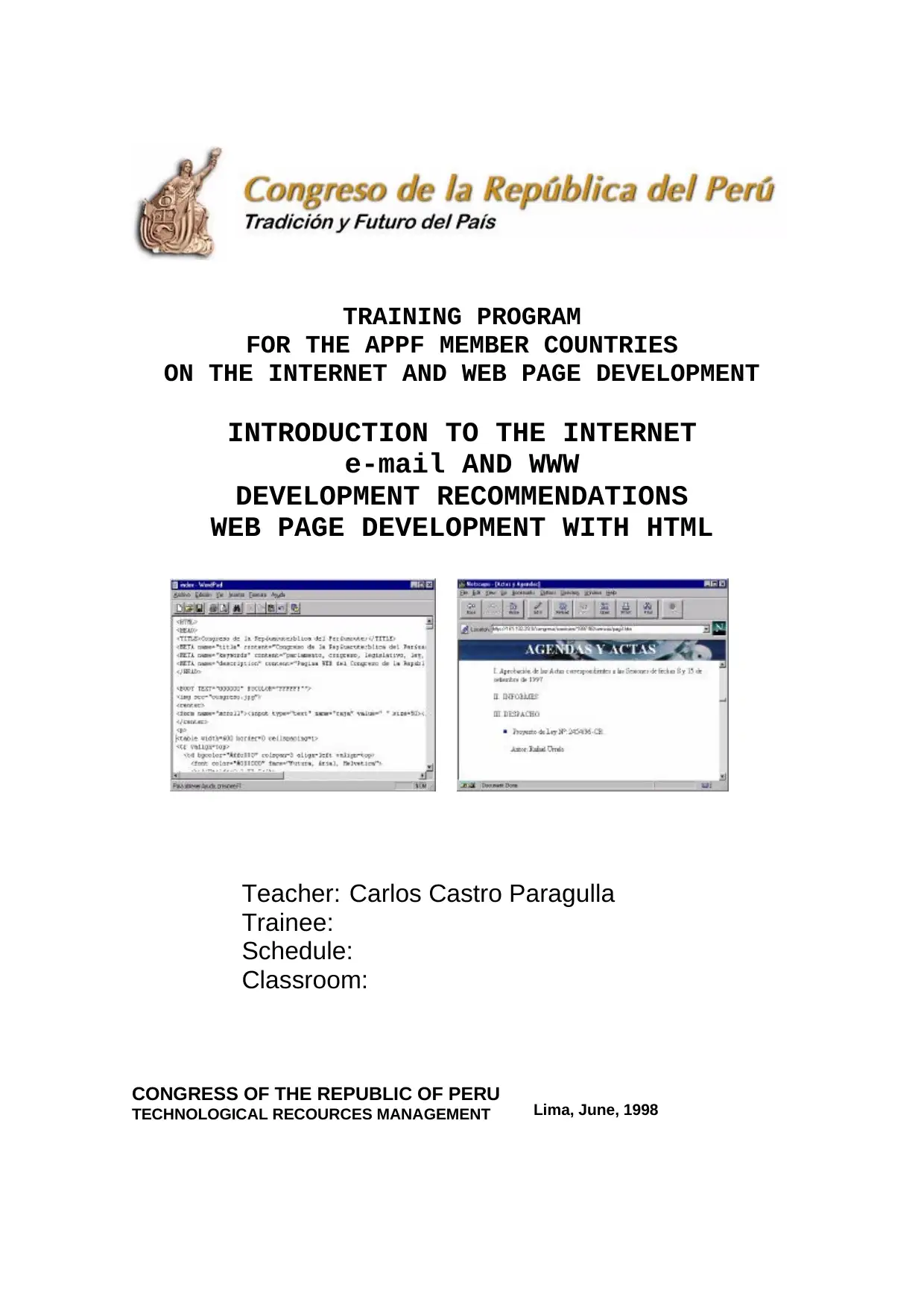
TRAINING PROGRAM
FOR THE APPF MEMBER COUNTRIES
ON THE INTERNET AND WEB PAGE DEVELOPMENT
INTRODUCTION TO THE INTERNET
e-mail AND WWW
DEVELOPMENT RECOMMENDATIONS
WEB PAGE DEVELOPMENT WITH HTML
Teacher: Carlos Castro Paragulla
Trainee:
Schedule:
Classroom:
CONGRESS OF THE REPUBLIC OF PERU
TECHNOLOGICAL RECOURCES MANAGEMENT Lima, June, 1998
FOR THE APPF MEMBER COUNTRIES
ON THE INTERNET AND WEB PAGE DEVELOPMENT
INTRODUCTION TO THE INTERNET
e-mail AND WWW
DEVELOPMENT RECOMMENDATIONS
WEB PAGE DEVELOPMENT WITH HTML
Teacher: Carlos Castro Paragulla
Trainee:
Schedule:
Classroom:
CONGRESS OF THE REPUBLIC OF PERU
TECHNOLOGICAL RECOURCES MANAGEMENT Lima, June, 1998
Paraphrase This Document
Need a fresh take? Get an instant paraphrase of this document with our AI Paraphraser
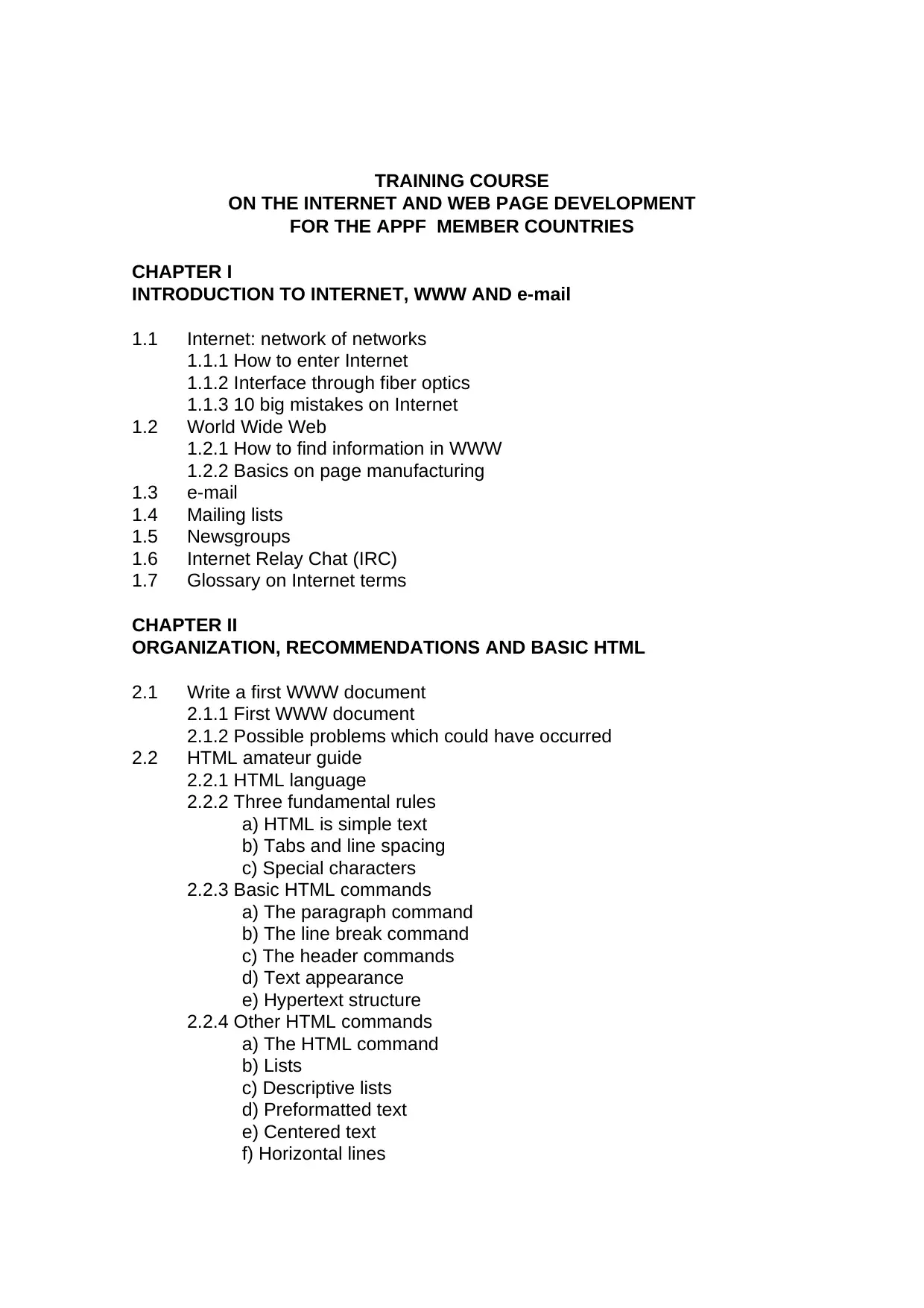
TRAINING COURSE
ON THE INTERNET AND WEB PAGE DEVELOPMENT
FOR THE APPF MEMBER COUNTRIES
CHAPTER I
INTRODUCTION TO INTERNET, WWW AND e-mail
1.1 Internet: network of networks
1.1.1 How to enter Internet
1.1.2 Interface through fiber optics
1.1.3 10 big mistakes on Internet
1.2 World Wide Web
1.2.1 How to find information in WWW
1.2.2 Basics on page manufacturing
1.3 e-mail
1.4 Mailing lists
1.5 Newsgroups
1.6 Internet Relay Chat (IRC)
1.7 Glossary on Internet terms
CHAPTER II
ORGANIZATION, RECOMMENDATIONS AND BASIC HTML
2.1 Write a first WWW document
2.1.1 First WWW document
2.1.2 Possible problems which could have occurred
2.2 HTML amateur guide
2.2.1 HTML language
2.2.2 Three fundamental rules
a) HTML is simple text
b) Tabs and line spacing
c) Special characters
2.2.3 Basic HTML commands
a) The paragraph command
b) The line break command
c) The header commands
d) Text appearance
e) Hypertext structure
2.2.4 Other HTML commands
a) The HTML command
b) Lists
c) Descriptive lists
d) Preformatted text
e) Centered text
f) Horizontal lines
ON THE INTERNET AND WEB PAGE DEVELOPMENT
FOR THE APPF MEMBER COUNTRIES
CHAPTER I
INTRODUCTION TO INTERNET, WWW AND e-mail
1.1 Internet: network of networks
1.1.1 How to enter Internet
1.1.2 Interface through fiber optics
1.1.3 10 big mistakes on Internet
1.2 World Wide Web
1.2.1 How to find information in WWW
1.2.2 Basics on page manufacturing
1.3 e-mail
1.4 Mailing lists
1.5 Newsgroups
1.6 Internet Relay Chat (IRC)
1.7 Glossary on Internet terms
CHAPTER II
ORGANIZATION, RECOMMENDATIONS AND BASIC HTML
2.1 Write a first WWW document
2.1.1 First WWW document
2.1.2 Possible problems which could have occurred
2.2 HTML amateur guide
2.2.1 HTML language
2.2.2 Three fundamental rules
a) HTML is simple text
b) Tabs and line spacing
c) Special characters
2.2.3 Basic HTML commands
a) The paragraph command
b) The line break command
c) The header commands
d) Text appearance
e) Hypertext structure
2.2.4 Other HTML commands
a) The HTML command
b) Lists
c) Descriptive lists
d) Preformatted text
e) Centered text
f) Horizontal lines
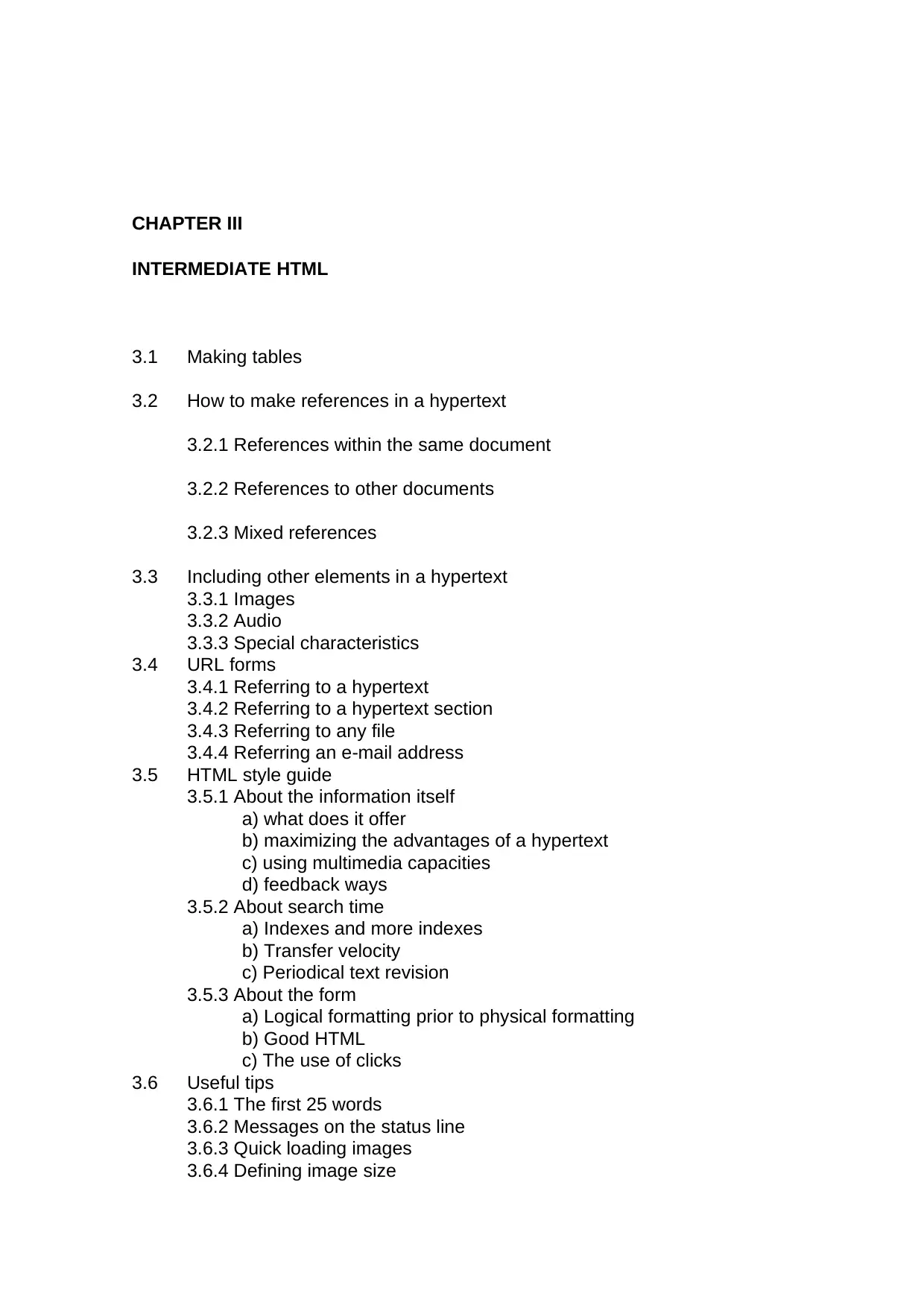
CHAPTER III
INTERMEDIATE HTML
3.1 Making tables
3.2 How to make references in a hypertext
3.2.1 References within the same document
3.2.2 References to other documents
3.2.3 Mixed references
3.3 Including other elements in a hypertext
3.3.1 Images
3.3.2 Audio
3.3.3 Special characteristics
3.4 URL forms
3.4.1 Referring to a hypertext
3.4.2 Referring to a hypertext section
3.4.3 Referring to any file
3.4.4 Referring an e-mail address
3.5 HTML style guide
3.5.1 About the information itself
a) what does it offer
b) maximizing the advantages of a hypertext
c) using multimedia capacities
d) feedback ways
3.5.2 About search time
a) Indexes and more indexes
b) Transfer velocity
c) Periodical text revision
3.5.3 About the form
a) Logical formatting prior to physical formatting
b) Good HTML
c) The use of clicks
3.6 Useful tips
3.6.1 The first 25 words
3.6.2 Messages on the status line
3.6.3 Quick loading images
3.6.4 Defining image size
INTERMEDIATE HTML
3.1 Making tables
3.2 How to make references in a hypertext
3.2.1 References within the same document
3.2.2 References to other documents
3.2.3 Mixed references
3.3 Including other elements in a hypertext
3.3.1 Images
3.3.2 Audio
3.3.3 Special characteristics
3.4 URL forms
3.4.1 Referring to a hypertext
3.4.2 Referring to a hypertext section
3.4.3 Referring to any file
3.4.4 Referring an e-mail address
3.5 HTML style guide
3.5.1 About the information itself
a) what does it offer
b) maximizing the advantages of a hypertext
c) using multimedia capacities
d) feedback ways
3.5.2 About search time
a) Indexes and more indexes
b) Transfer velocity
c) Periodical text revision
3.5.3 About the form
a) Logical formatting prior to physical formatting
b) Good HTML
c) The use of clicks
3.6 Useful tips
3.6.1 The first 25 words
3.6.2 Messages on the status line
3.6.3 Quick loading images
3.6.4 Defining image size
⊘ This is a preview!⊘
Do you want full access?
Subscribe today to unlock all pages.

Trusted by 1+ million students worldwide
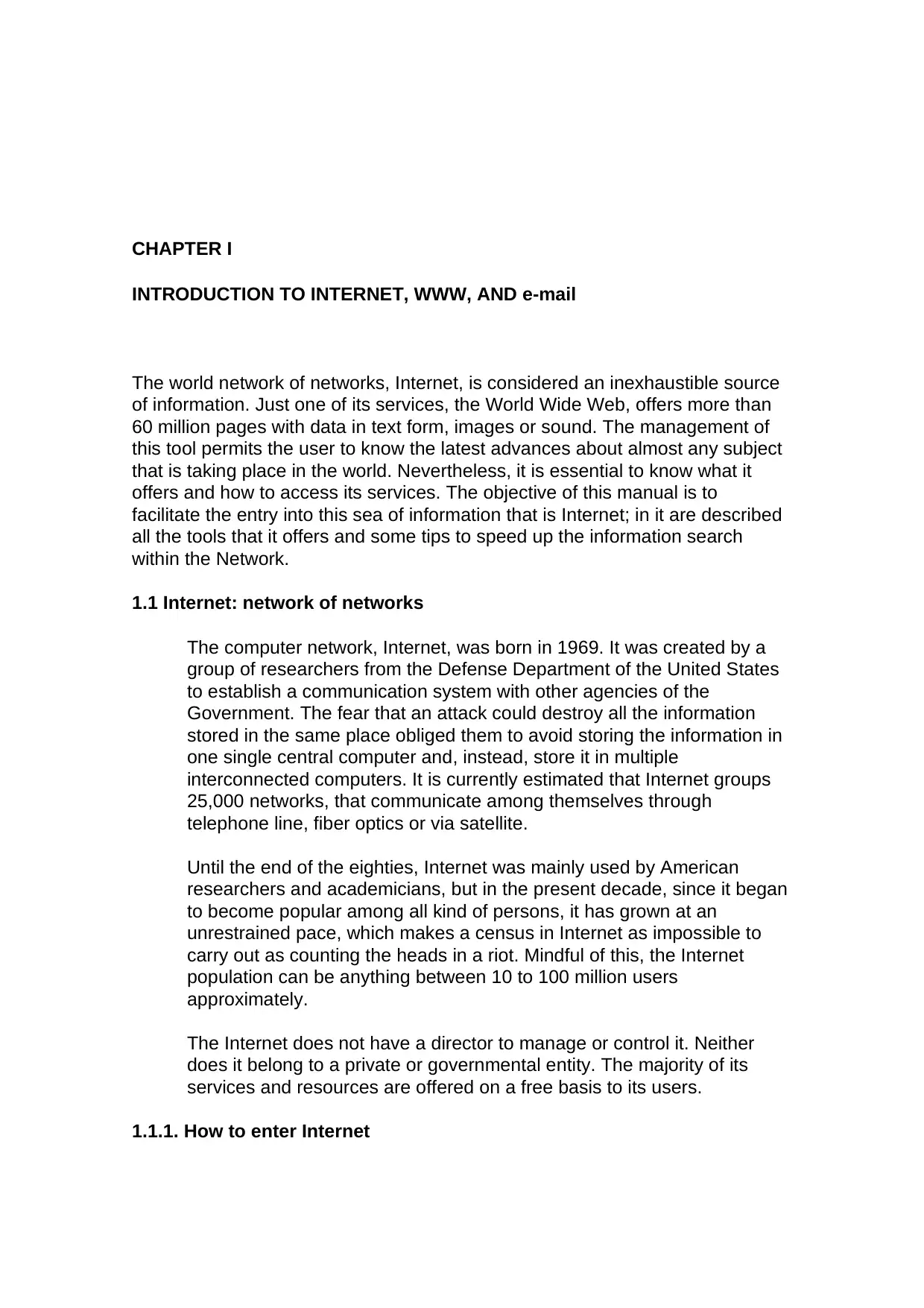
CHAPTER I
INTRODUCTION TO INTERNET, WWW, AND e-mail
The world network of networks, Internet, is considered an inexhaustible source
of information. Just one of its services, the World Wide Web, offers more than
60 million pages with data in text form, images or sound. The management of
this tool permits the user to know the latest advances about almost any subject
that is taking place in the world. Nevertheless, it is essential to know what it
offers and how to access its services. The objective of this manual is to
facilitate the entry into this sea of information that is Internet; in it are described
all the tools that it offers and some tips to speed up the information search
within the Network.
1.1 Internet: network of networks
The computer network, Internet, was born in 1969. It was created by a
group of researchers from the Defense Department of the United States
to establish a communication system with other agencies of the
Government. The fear that an attack could destroy all the information
stored in the same place obliged them to avoid storing the information in
one single central computer and, instead, store it in multiple
interconnected computers. It is currently estimated that Internet groups
25,000 networks, that communicate among themselves through
telephone line, fiber optics or via satellite.
Until the end of the eighties, Internet was mainly used by American
researchers and academicians, but in the present decade, since it began
to become popular among all kind of persons, it has grown at an
unrestrained pace, which makes a census in Internet as impossible to
carry out as counting the heads in a riot. Mindful of this, the Internet
population can be anything between 10 to 100 million users
approximately.
The Internet does not have a director to manage or control it. Neither
does it belong to a private or governmental entity. The majority of its
services and resources are offered on a free basis to its users.
1.1.1. How to enter Internet
INTRODUCTION TO INTERNET, WWW, AND e-mail
The world network of networks, Internet, is considered an inexhaustible source
of information. Just one of its services, the World Wide Web, offers more than
60 million pages with data in text form, images or sound. The management of
this tool permits the user to know the latest advances about almost any subject
that is taking place in the world. Nevertheless, it is essential to know what it
offers and how to access its services. The objective of this manual is to
facilitate the entry into this sea of information that is Internet; in it are described
all the tools that it offers and some tips to speed up the information search
within the Network.
1.1 Internet: network of networks
The computer network, Internet, was born in 1969. It was created by a
group of researchers from the Defense Department of the United States
to establish a communication system with other agencies of the
Government. The fear that an attack could destroy all the information
stored in the same place obliged them to avoid storing the information in
one single central computer and, instead, store it in multiple
interconnected computers. It is currently estimated that Internet groups
25,000 networks, that communicate among themselves through
telephone line, fiber optics or via satellite.
Until the end of the eighties, Internet was mainly used by American
researchers and academicians, but in the present decade, since it began
to become popular among all kind of persons, it has grown at an
unrestrained pace, which makes a census in Internet as impossible to
carry out as counting the heads in a riot. Mindful of this, the Internet
population can be anything between 10 to 100 million users
approximately.
The Internet does not have a director to manage or control it. Neither
does it belong to a private or governmental entity. The majority of its
services and resources are offered on a free basis to its users.
1.1.1. How to enter Internet
Paraphrase This Document
Need a fresh take? Get an instant paraphrase of this document with our AI Paraphraser
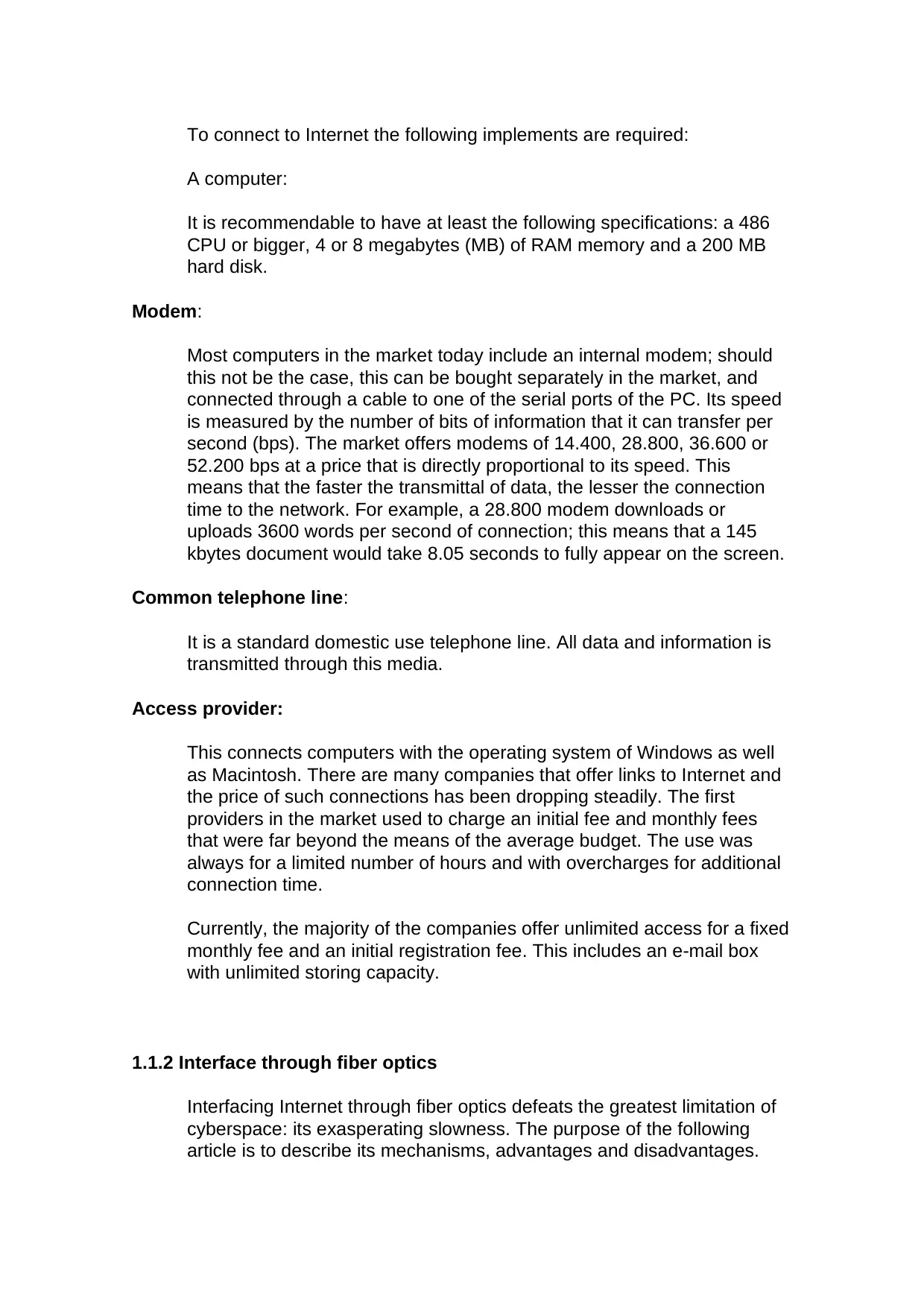
To connect to Internet the following implements are required:
A computer:
It is recommendable to have at least the following specifications: a 486
CPU or bigger, 4 or 8 megabytes (MB) of RAM memory and a 200 MB
hard disk.
Modem:
Most computers in the market today include an internal modem; should
this not be the case, this can be bought separately in the market, and
connected through a cable to one of the serial ports of the PC. Its speed
is measured by the number of bits of information that it can transfer per
second (bps). The market offers modems of 14.400, 28.800, 36.600 or
52.200 bps at a price that is directly proportional to its speed. This
means that the faster the transmittal of data, the lesser the connection
time to the network. For example, a 28.800 modem downloads or
uploads 3600 words per second of connection; this means that a 145
kbytes document would take 8.05 seconds to fully appear on the screen.
Common telephone line:
It is a standard domestic use telephone line. All data and information is
transmitted through this media.
Access provider:
This connects computers with the operating system of Windows as well
as Macintosh. There are many companies that offer links to Internet and
the price of such connections has been dropping steadily. The first
providers in the market used to charge an initial fee and monthly fees
that were far beyond the means of the average budget. The use was
always for a limited number of hours and with overcharges for additional
connection time.
Currently, the majority of the companies offer unlimited access for a fixed
monthly fee and an initial registration fee. This includes an e-mail box
with unlimited storing capacity.
1.1.2 Interface through fiber optics
Interfacing Internet through fiber optics defeats the greatest limitation of
cyberspace: its exasperating slowness. The purpose of the following
article is to describe its mechanisms, advantages and disadvantages.
A computer:
It is recommendable to have at least the following specifications: a 486
CPU or bigger, 4 or 8 megabytes (MB) of RAM memory and a 200 MB
hard disk.
Modem:
Most computers in the market today include an internal modem; should
this not be the case, this can be bought separately in the market, and
connected through a cable to one of the serial ports of the PC. Its speed
is measured by the number of bits of information that it can transfer per
second (bps). The market offers modems of 14.400, 28.800, 36.600 or
52.200 bps at a price that is directly proportional to its speed. This
means that the faster the transmittal of data, the lesser the connection
time to the network. For example, a 28.800 modem downloads or
uploads 3600 words per second of connection; this means that a 145
kbytes document would take 8.05 seconds to fully appear on the screen.
Common telephone line:
It is a standard domestic use telephone line. All data and information is
transmitted through this media.
Access provider:
This connects computers with the operating system of Windows as well
as Macintosh. There are many companies that offer links to Internet and
the price of such connections has been dropping steadily. The first
providers in the market used to charge an initial fee and monthly fees
that were far beyond the means of the average budget. The use was
always for a limited number of hours and with overcharges for additional
connection time.
Currently, the majority of the companies offer unlimited access for a fixed
monthly fee and an initial registration fee. This includes an e-mail box
with unlimited storing capacity.
1.1.2 Interface through fiber optics
Interfacing Internet through fiber optics defeats the greatest limitation of
cyberspace: its exasperating slowness. The purpose of the following
article is to describe its mechanisms, advantages and disadvantages.
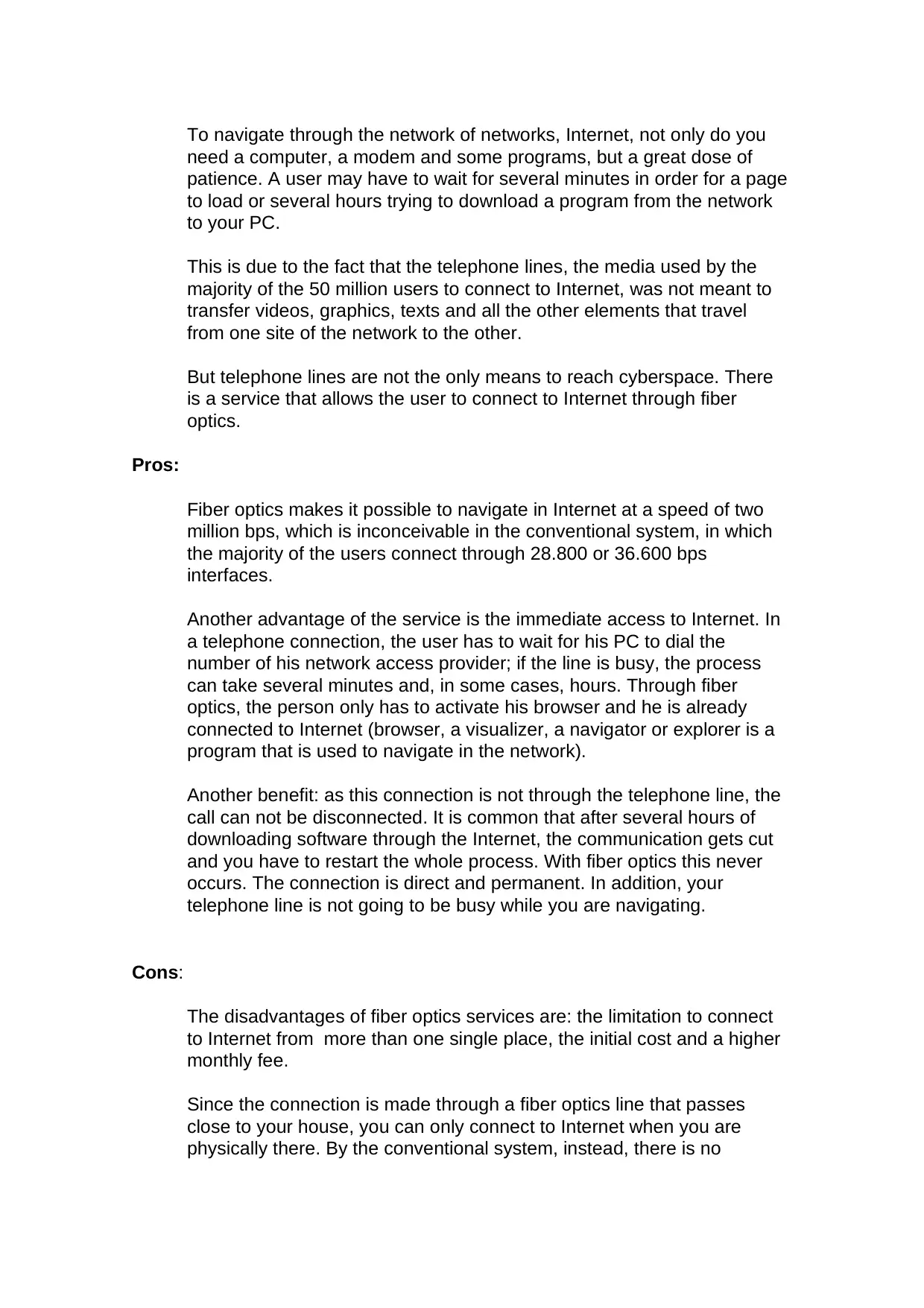
To navigate through the network of networks, Internet, not only do you
need a computer, a modem and some programs, but a great dose of
patience. A user may have to wait for several minutes in order for a page
to load or several hours trying to download a program from the network
to your PC.
This is due to the fact that the telephone lines, the media used by the
majority of the 50 million users to connect to Internet, was not meant to
transfer videos, graphics, texts and all the other elements that travel
from one site of the network to the other.
But telephone lines are not the only means to reach cyberspace. There
is a service that allows the user to connect to Internet through fiber
optics.
Pros:
Fiber optics makes it possible to navigate in Internet at a speed of two
million bps, which is inconceivable in the conventional system, in which
the majority of the users connect through 28.800 or 36.600 bps
interfaces.
Another advantage of the service is the immediate access to Internet. In
a telephone connection, the user has to wait for his PC to dial the
number of his network access provider; if the line is busy, the process
can take several minutes and, in some cases, hours. Through fiber
optics, the person only has to activate his browser and he is already
connected to Internet (browser, a visualizer, a navigator or explorer is a
program that is used to navigate in the network).
Another benefit: as this connection is not through the telephone line, the
call can not be disconnected. It is common that after several hours of
downloading software through the Internet, the communication gets cut
and you have to restart the whole process. With fiber optics this never
occurs. The connection is direct and permanent. In addition, your
telephone line is not going to be busy while you are navigating.
Cons:
The disadvantages of fiber optics services are: the limitation to connect
to Internet from more than one single place, the initial cost and a higher
monthly fee.
Since the connection is made through a fiber optics line that passes
close to your house, you can only connect to Internet when you are
physically there. By the conventional system, instead, there is no
need a computer, a modem and some programs, but a great dose of
patience. A user may have to wait for several minutes in order for a page
to load or several hours trying to download a program from the network
to your PC.
This is due to the fact that the telephone lines, the media used by the
majority of the 50 million users to connect to Internet, was not meant to
transfer videos, graphics, texts and all the other elements that travel
from one site of the network to the other.
But telephone lines are not the only means to reach cyberspace. There
is a service that allows the user to connect to Internet through fiber
optics.
Pros:
Fiber optics makes it possible to navigate in Internet at a speed of two
million bps, which is inconceivable in the conventional system, in which
the majority of the users connect through 28.800 or 36.600 bps
interfaces.
Another advantage of the service is the immediate access to Internet. In
a telephone connection, the user has to wait for his PC to dial the
number of his network access provider; if the line is busy, the process
can take several minutes and, in some cases, hours. Through fiber
optics, the person only has to activate his browser and he is already
connected to Internet (browser, a visualizer, a navigator or explorer is a
program that is used to navigate in the network).
Another benefit: as this connection is not through the telephone line, the
call can not be disconnected. It is common that after several hours of
downloading software through the Internet, the communication gets cut
and you have to restart the whole process. With fiber optics this never
occurs. The connection is direct and permanent. In addition, your
telephone line is not going to be busy while you are navigating.
Cons:
The disadvantages of fiber optics services are: the limitation to connect
to Internet from more than one single place, the initial cost and a higher
monthly fee.
Since the connection is made through a fiber optics line that passes
close to your house, you can only connect to Internet when you are
physically there. By the conventional system, instead, there is no
⊘ This is a preview!⊘
Do you want full access?
Subscribe today to unlock all pages.

Trusted by 1+ million students worldwide
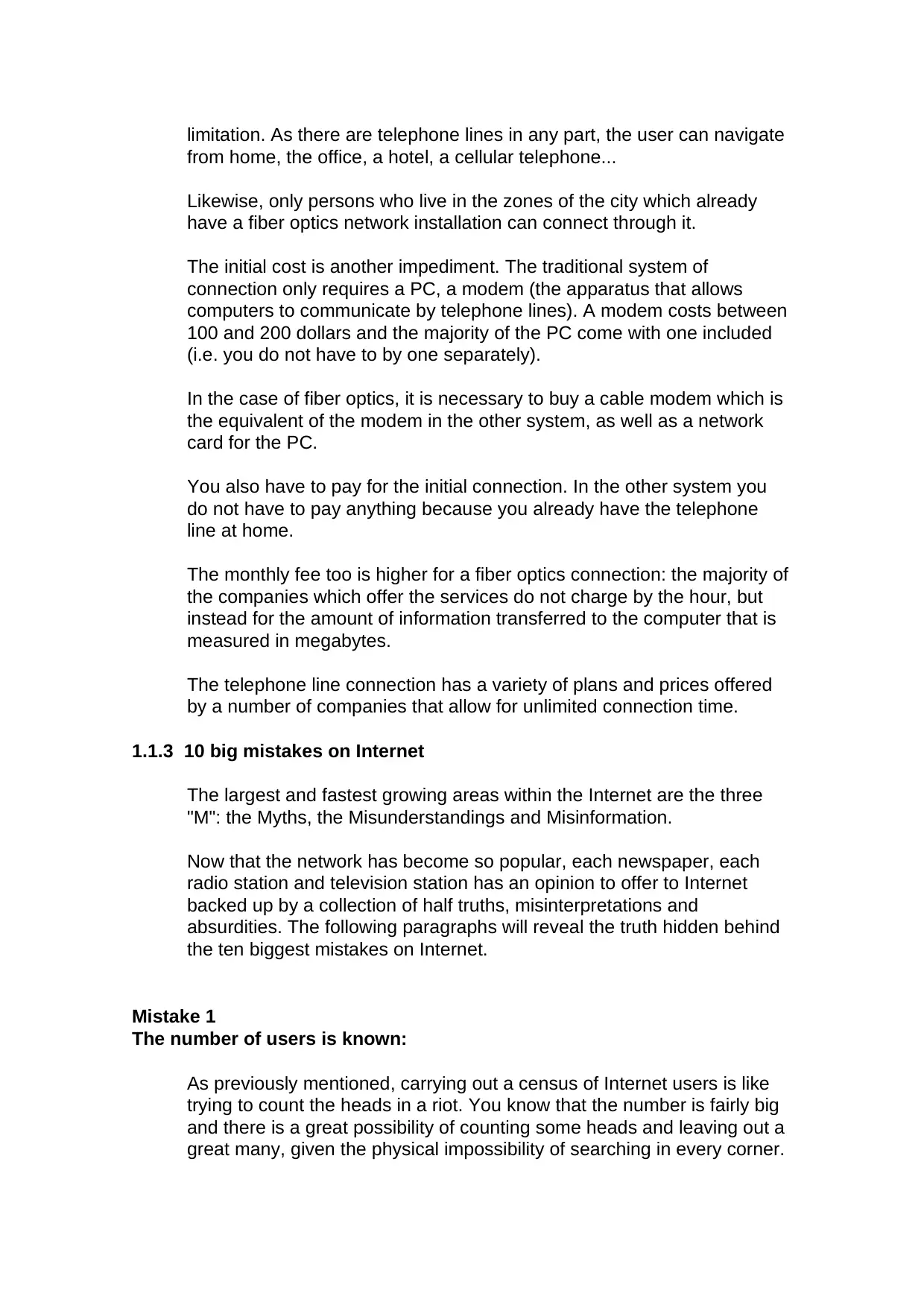
limitation. As there are telephone lines in any part, the user can navigate
from home, the office, a hotel, a cellular telephone...
Likewise, only persons who live in the zones of the city which already
have a fiber optics network installation can connect through it.
The initial cost is another impediment. The traditional system of
connection only requires a PC, a modem (the apparatus that allows
computers to communicate by telephone lines). A modem costs between
100 and 200 dollars and the majority of the PC come with one included
(i.e. you do not have to by one separately).
In the case of fiber optics, it is necessary to buy a cable modem which is
the equivalent of the modem in the other system, as well as a network
card for the PC.
You also have to pay for the initial connection. In the other system you
do not have to pay anything because you already have the telephone
line at home.
The monthly fee too is higher for a fiber optics connection: the majority of
the companies which offer the services do not charge by the hour, but
instead for the amount of information transferred to the computer that is
measured in megabytes.
The telephone line connection has a variety of plans and prices offered
by a number of companies that allow for unlimited connection time.
1.1.3 10 big mistakes on Internet
The largest and fastest growing areas within the Internet are the three
"M": the Myths, the Misunderstandings and Misinformation.
Now that the network has become so popular, each newspaper, each
radio station and television station has an opinion to offer to Internet
backed up by a collection of half truths, misinterpretations and
absurdities. The following paragraphs will reveal the truth hidden behind
the ten biggest mistakes on Internet.
Mistake 1
The number of users is known:
As previously mentioned, carrying out a census of Internet users is like
trying to count the heads in a riot. You know that the number is fairly big
and there is a great possibility of counting some heads and leaving out a
great many, given the physical impossibility of searching in every corner.
from home, the office, a hotel, a cellular telephone...
Likewise, only persons who live in the zones of the city which already
have a fiber optics network installation can connect through it.
The initial cost is another impediment. The traditional system of
connection only requires a PC, a modem (the apparatus that allows
computers to communicate by telephone lines). A modem costs between
100 and 200 dollars and the majority of the PC come with one included
(i.e. you do not have to by one separately).
In the case of fiber optics, it is necessary to buy a cable modem which is
the equivalent of the modem in the other system, as well as a network
card for the PC.
You also have to pay for the initial connection. In the other system you
do not have to pay anything because you already have the telephone
line at home.
The monthly fee too is higher for a fiber optics connection: the majority of
the companies which offer the services do not charge by the hour, but
instead for the amount of information transferred to the computer that is
measured in megabytes.
The telephone line connection has a variety of plans and prices offered
by a number of companies that allow for unlimited connection time.
1.1.3 10 big mistakes on Internet
The largest and fastest growing areas within the Internet are the three
"M": the Myths, the Misunderstandings and Misinformation.
Now that the network has become so popular, each newspaper, each
radio station and television station has an opinion to offer to Internet
backed up by a collection of half truths, misinterpretations and
absurdities. The following paragraphs will reveal the truth hidden behind
the ten biggest mistakes on Internet.
Mistake 1
The number of users is known:
As previously mentioned, carrying out a census of Internet users is like
trying to count the heads in a riot. You know that the number is fairly big
and there is a great possibility of counting some heads and leaving out a
great many, given the physical impossibility of searching in every corner.
Paraphrase This Document
Need a fresh take? Get an instant paraphrase of this document with our AI Paraphraser
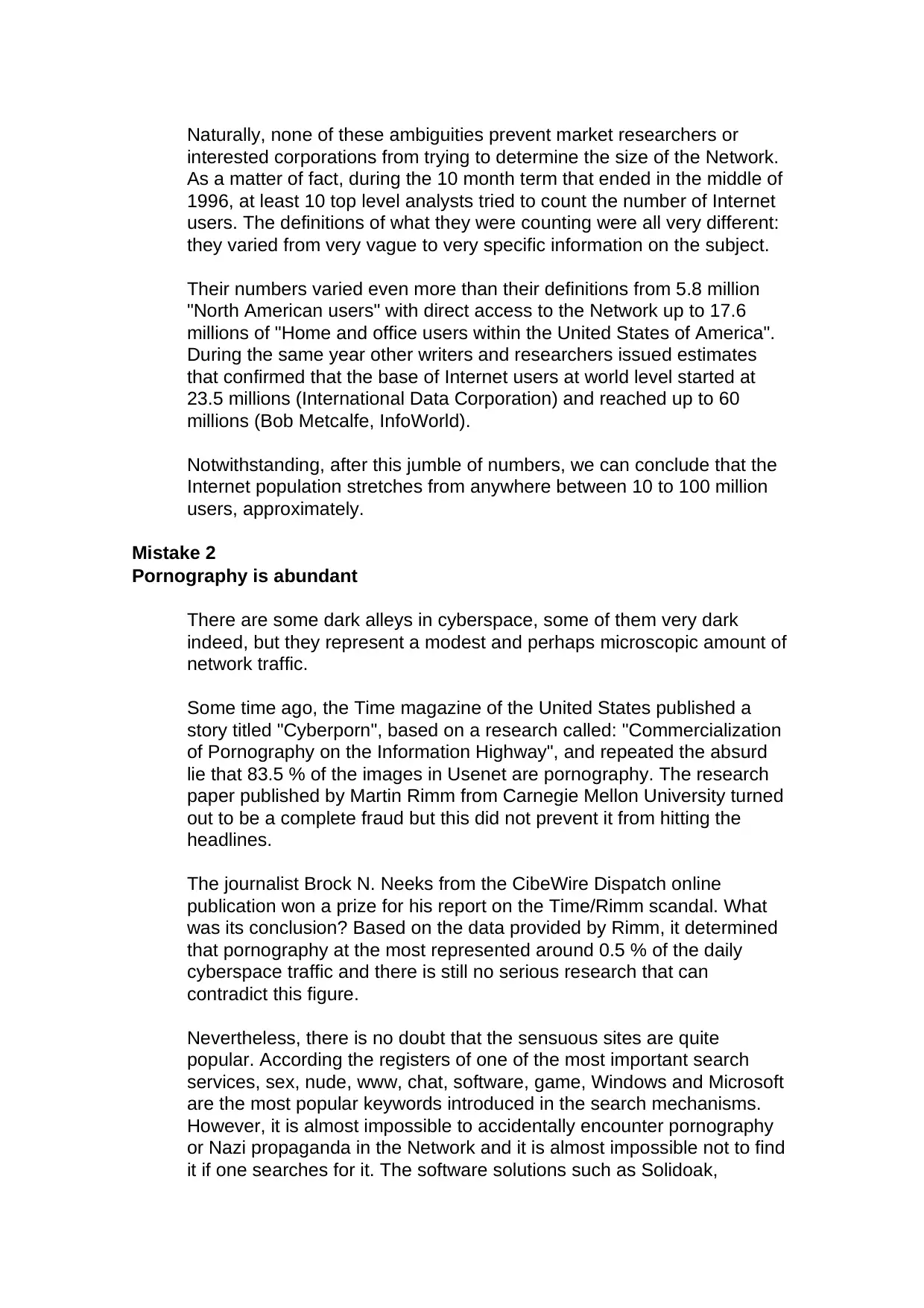
Naturally, none of these ambiguities prevent market researchers or
interested corporations from trying to determine the size of the Network.
As a matter of fact, during the 10 month term that ended in the middle of
1996, at least 10 top level analysts tried to count the number of Internet
users. The definitions of what they were counting were all very different:
they varied from very vague to very specific information on the subject.
Their numbers varied even more than their definitions from 5.8 million
"North American users" with direct access to the Network up to 17.6
millions of "Home and office users within the United States of America".
During the same year other writers and researchers issued estimates
that confirmed that the base of Internet users at world level started at
23.5 millions (International Data Corporation) and reached up to 60
millions (Bob Metcalfe, InfoWorld).
Notwithstanding, after this jumble of numbers, we can conclude that the
Internet population stretches from anywhere between 10 to 100 million
users, approximately.
Mistake 2
Pornography is abundant
There are some dark alleys in cyberspace, some of them very dark
indeed, but they represent a modest and perhaps microscopic amount of
network traffic.
Some time ago, the Time magazine of the United States published a
story titled "Cyberporn", based on a research called: "Commercialization
of Pornography on the Information Highway", and repeated the absurd
lie that 83.5 % of the images in Usenet are pornography. The research
paper published by Martin Rimm from Carnegie Mellon University turned
out to be a complete fraud but this did not prevent it from hitting the
headlines.
The journalist Brock N. Neeks from the CibeWire Dispatch online
publication won a prize for his report on the Time/Rimm scandal. What
was its conclusion? Based on the data provided by Rimm, it determined
that pornography at the most represented around 0.5 % of the daily
cyberspace traffic and there is still no serious research that can
contradict this figure.
Nevertheless, there is no doubt that the sensuous sites are quite
popular. According the registers of one of the most important search
services, sex, nude, www, chat, software, game, Windows and Microsoft
are the most popular keywords introduced in the search mechanisms.
However, it is almost impossible to accidentally encounter pornography
or Nazi propaganda in the Network and it is almost impossible not to find
it if one searches for it. The software solutions such as Solidoak,
interested corporations from trying to determine the size of the Network.
As a matter of fact, during the 10 month term that ended in the middle of
1996, at least 10 top level analysts tried to count the number of Internet
users. The definitions of what they were counting were all very different:
they varied from very vague to very specific information on the subject.
Their numbers varied even more than their definitions from 5.8 million
"North American users" with direct access to the Network up to 17.6
millions of "Home and office users within the United States of America".
During the same year other writers and researchers issued estimates
that confirmed that the base of Internet users at world level started at
23.5 millions (International Data Corporation) and reached up to 60
millions (Bob Metcalfe, InfoWorld).
Notwithstanding, after this jumble of numbers, we can conclude that the
Internet population stretches from anywhere between 10 to 100 million
users, approximately.
Mistake 2
Pornography is abundant
There are some dark alleys in cyberspace, some of them very dark
indeed, but they represent a modest and perhaps microscopic amount of
network traffic.
Some time ago, the Time magazine of the United States published a
story titled "Cyberporn", based on a research called: "Commercialization
of Pornography on the Information Highway", and repeated the absurd
lie that 83.5 % of the images in Usenet are pornography. The research
paper published by Martin Rimm from Carnegie Mellon University turned
out to be a complete fraud but this did not prevent it from hitting the
headlines.
The journalist Brock N. Neeks from the CibeWire Dispatch online
publication won a prize for his report on the Time/Rimm scandal. What
was its conclusion? Based on the data provided by Rimm, it determined
that pornography at the most represented around 0.5 % of the daily
cyberspace traffic and there is still no serious research that can
contradict this figure.
Nevertheless, there is no doubt that the sensuous sites are quite
popular. According the registers of one of the most important search
services, sex, nude, www, chat, software, game, Windows and Microsoft
are the most popular keywords introduced in the search mechanisms.
However, it is almost impossible to accidentally encounter pornography
or Nazi propaganda in the Network and it is almost impossible not to find
it if one searches for it. The software solutions such as Solidoak,
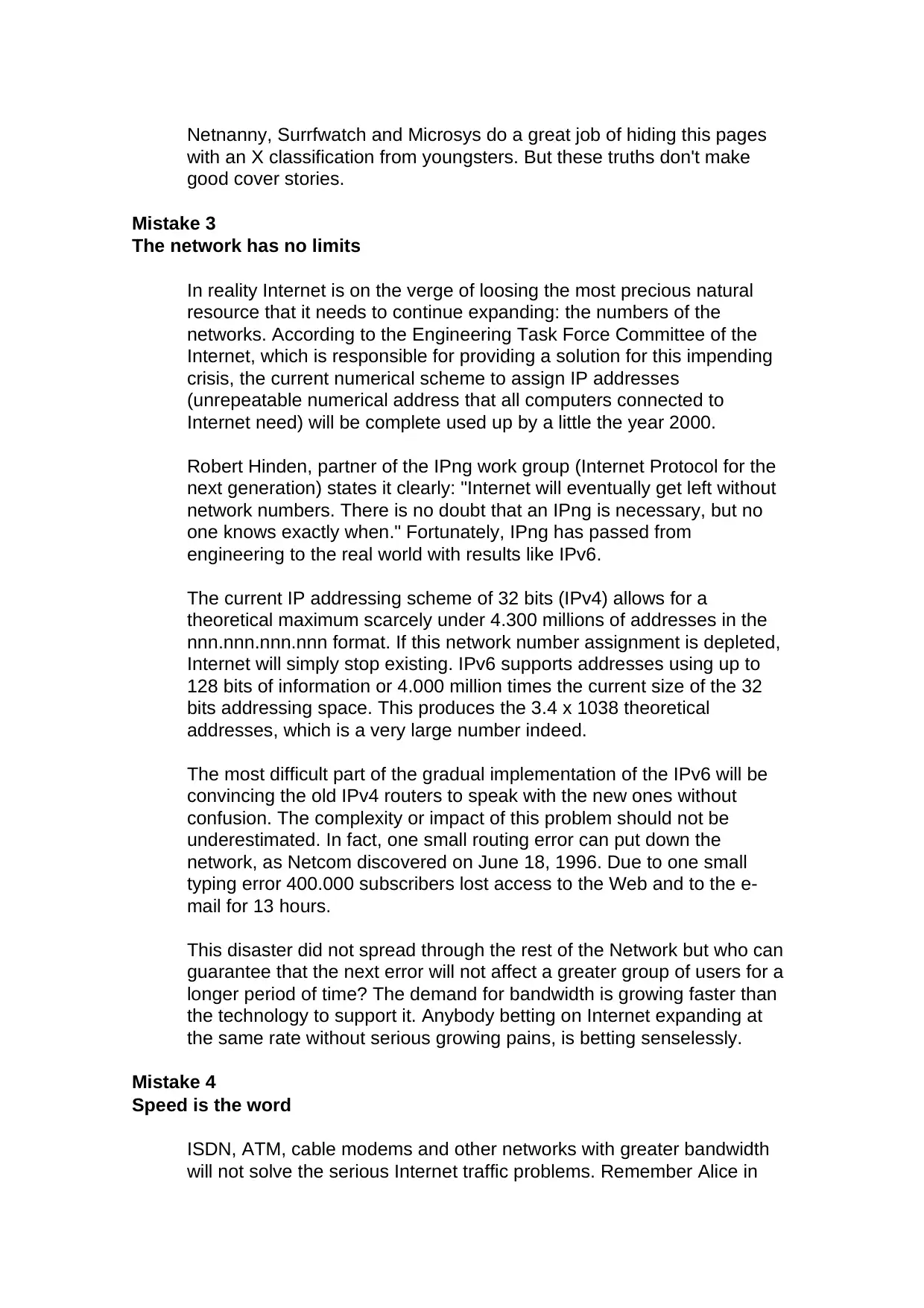
Netnanny, Surrfwatch and Microsys do a great job of hiding this pages
with an X classification from youngsters. But these truths don't make
good cover stories.
Mistake 3
The network has no limits
In reality Internet is on the verge of loosing the most precious natural
resource that it needs to continue expanding: the numbers of the
networks. According to the Engineering Task Force Committee of the
Internet, which is responsible for providing a solution for this impending
crisis, the current numerical scheme to assign IP addresses
(unrepeatable numerical address that all computers connected to
Internet need) will be complete used up by a little the year 2000.
Robert Hinden, partner of the IPng work group (Internet Protocol for the
next generation) states it clearly: "Internet will eventually get left without
network numbers. There is no doubt that an IPng is necessary, but no
one knows exactly when." Fortunately, IPng has passed from
engineering to the real world with results like IPv6.
The current IP addressing scheme of 32 bits (IPv4) allows for a
theoretical maximum scarcely under 4.300 millions of addresses in the
nnn.nnn.nnn.nnn format. If this network number assignment is depleted,
Internet will simply stop existing. IPv6 supports addresses using up to
128 bits of information or 4.000 million times the current size of the 32
bits addressing space. This produces the 3.4 x 1038 theoretical
addresses, which is a very large number indeed.
The most difficult part of the gradual implementation of the IPv6 will be
convincing the old IPv4 routers to speak with the new ones without
confusion. The complexity or impact of this problem should not be
underestimated. In fact, one small routing error can put down the
network, as Netcom discovered on June 18, 1996. Due to one small
typing error 400.000 subscribers lost access to the Web and to the e-
mail for 13 hours.
This disaster did not spread through the rest of the Network but who can
guarantee that the next error will not affect a greater group of users for a
longer period of time? The demand for bandwidth is growing faster than
the technology to support it. Anybody betting on Internet expanding at
the same rate without serious growing pains, is betting senselessly.
Mistake 4
Speed is the word
ISDN, ATM, cable modems and other networks with greater bandwidth
will not solve the serious Internet traffic problems. Remember Alice in
with an X classification from youngsters. But these truths don't make
good cover stories.
Mistake 3
The network has no limits
In reality Internet is on the verge of loosing the most precious natural
resource that it needs to continue expanding: the numbers of the
networks. According to the Engineering Task Force Committee of the
Internet, which is responsible for providing a solution for this impending
crisis, the current numerical scheme to assign IP addresses
(unrepeatable numerical address that all computers connected to
Internet need) will be complete used up by a little the year 2000.
Robert Hinden, partner of the IPng work group (Internet Protocol for the
next generation) states it clearly: "Internet will eventually get left without
network numbers. There is no doubt that an IPng is necessary, but no
one knows exactly when." Fortunately, IPng has passed from
engineering to the real world with results like IPv6.
The current IP addressing scheme of 32 bits (IPv4) allows for a
theoretical maximum scarcely under 4.300 millions of addresses in the
nnn.nnn.nnn.nnn format. If this network number assignment is depleted,
Internet will simply stop existing. IPv6 supports addresses using up to
128 bits of information or 4.000 million times the current size of the 32
bits addressing space. This produces the 3.4 x 1038 theoretical
addresses, which is a very large number indeed.
The most difficult part of the gradual implementation of the IPv6 will be
convincing the old IPv4 routers to speak with the new ones without
confusion. The complexity or impact of this problem should not be
underestimated. In fact, one small routing error can put down the
network, as Netcom discovered on June 18, 1996. Due to one small
typing error 400.000 subscribers lost access to the Web and to the e-
mail for 13 hours.
This disaster did not spread through the rest of the Network but who can
guarantee that the next error will not affect a greater group of users for a
longer period of time? The demand for bandwidth is growing faster than
the technology to support it. Anybody betting on Internet expanding at
the same rate without serious growing pains, is betting senselessly.
Mistake 4
Speed is the word
ISDN, ATM, cable modems and other networks with greater bandwidth
will not solve the serious Internet traffic problems. Remember Alice in
⊘ This is a preview!⊘
Do you want full access?
Subscribe today to unlock all pages.

Trusted by 1+ million students worldwide
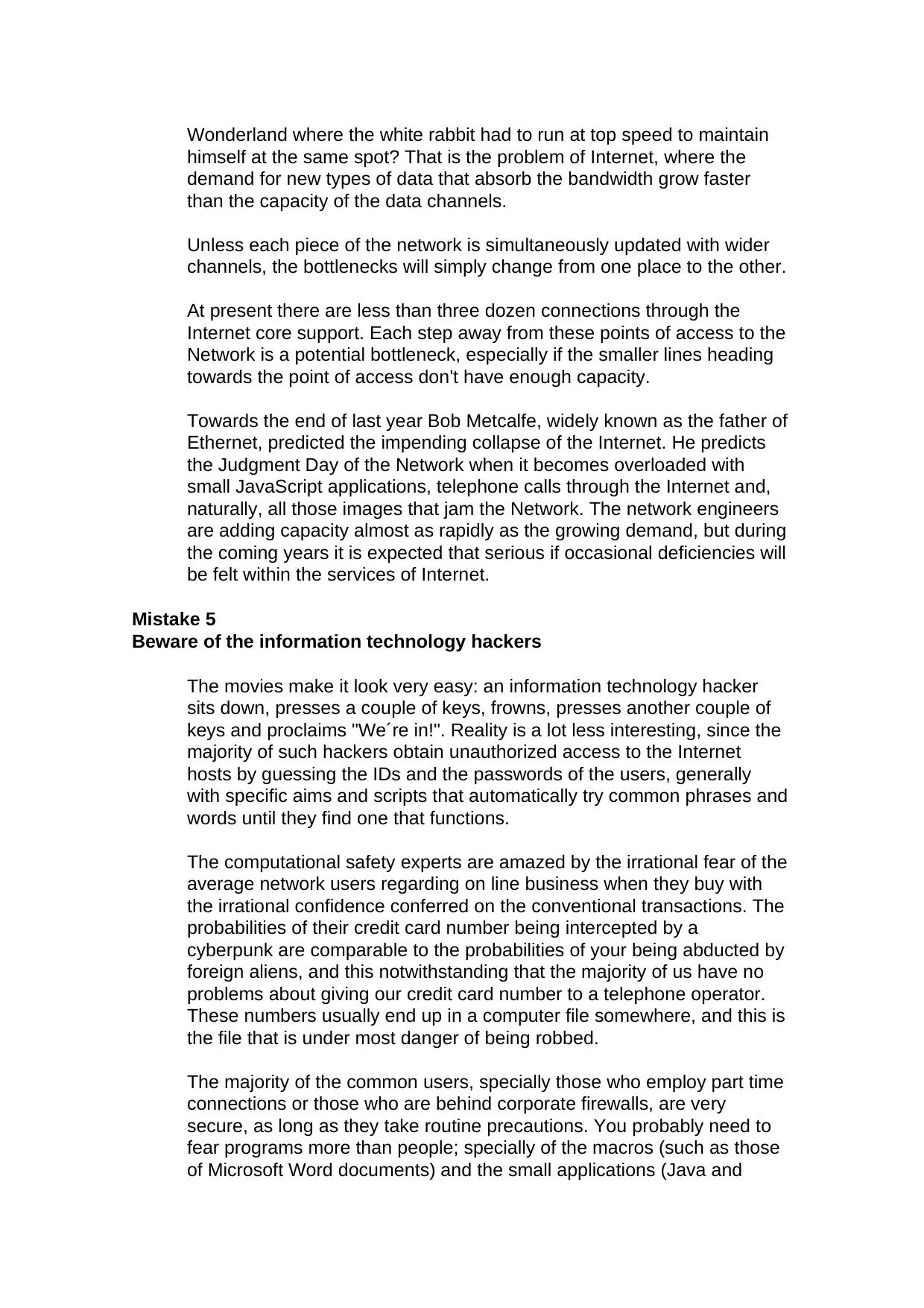
Wonderland where the white rabbit had to run at top speed to maintain
himself at the same spot? That is the problem of Internet, where the
demand for new types of data that absorb the bandwidth grow faster
than the capacity of the data channels.
Unless each piece of the network is simultaneously updated with wider
channels, the bottlenecks will simply change from one place to the other.
At present there are less than three dozen connections through the
Internet core support. Each step away from these points of access to the
Network is a potential bottleneck, especially if the smaller lines heading
towards the point of access don't have enough capacity.
Towards the end of last year Bob Metcalfe, widely known as the father of
Ethernet, predicted the impending collapse of the Internet. He predicts
the Judgment Day of the Network when it becomes overloaded with
small JavaScript applications, telephone calls through the Internet and,
naturally, all those images that jam the Network. The network engineers
are adding capacity almost as rapidly as the growing demand, but during
the coming years it is expected that serious if occasional deficiencies will
be felt within the services of Internet.
Mistake 5
Beware of the information technology hackers
The movies make it look very easy: an information technology hacker
sits down, presses a couple of keys, frowns, presses another couple of
keys and proclaims "We´re in!". Reality is a lot less interesting, since the
majority of such hackers obtain unauthorized access to the Internet
hosts by guessing the IDs and the passwords of the users, generally
with specific aims and scripts that automatically try common phrases and
words until they find one that functions.
The computational safety experts are amazed by the irrational fear of the
average network users regarding on line business when they buy with
the irrational confidence conferred on the conventional transactions. The
probabilities of their credit card number being intercepted by a
cyberpunk are comparable to the probabilities of your being abducted by
foreign aliens, and this notwithstanding that the majority of us have no
problems about giving our credit card number to a telephone operator.
These numbers usually end up in a computer file somewhere, and this is
the file that is under most danger of being robbed.
The majority of the common users, specially those who employ part time
connections or those who are behind corporate firewalls, are very
secure, as long as they take routine precautions. You probably need to
fear programs more than people; specially of the macros (such as those
of Microsoft Word documents) and the small applications (Java and
himself at the same spot? That is the problem of Internet, where the
demand for new types of data that absorb the bandwidth grow faster
than the capacity of the data channels.
Unless each piece of the network is simultaneously updated with wider
channels, the bottlenecks will simply change from one place to the other.
At present there are less than three dozen connections through the
Internet core support. Each step away from these points of access to the
Network is a potential bottleneck, especially if the smaller lines heading
towards the point of access don't have enough capacity.
Towards the end of last year Bob Metcalfe, widely known as the father of
Ethernet, predicted the impending collapse of the Internet. He predicts
the Judgment Day of the Network when it becomes overloaded with
small JavaScript applications, telephone calls through the Internet and,
naturally, all those images that jam the Network. The network engineers
are adding capacity almost as rapidly as the growing demand, but during
the coming years it is expected that serious if occasional deficiencies will
be felt within the services of Internet.
Mistake 5
Beware of the information technology hackers
The movies make it look very easy: an information technology hacker
sits down, presses a couple of keys, frowns, presses another couple of
keys and proclaims "We´re in!". Reality is a lot less interesting, since the
majority of such hackers obtain unauthorized access to the Internet
hosts by guessing the IDs and the passwords of the users, generally
with specific aims and scripts that automatically try common phrases and
words until they find one that functions.
The computational safety experts are amazed by the irrational fear of the
average network users regarding on line business when they buy with
the irrational confidence conferred on the conventional transactions. The
probabilities of their credit card number being intercepted by a
cyberpunk are comparable to the probabilities of your being abducted by
foreign aliens, and this notwithstanding that the majority of us have no
problems about giving our credit card number to a telephone operator.
These numbers usually end up in a computer file somewhere, and this is
the file that is under most danger of being robbed.
The majority of the common users, specially those who employ part time
connections or those who are behind corporate firewalls, are very
secure, as long as they take routine precautions. You probably need to
fear programs more than people; specially of the macros (such as those
of Microsoft Word documents) and the small applications (Java and
Paraphrase This Document
Need a fresh take? Get an instant paraphrase of this document with our AI Paraphraser
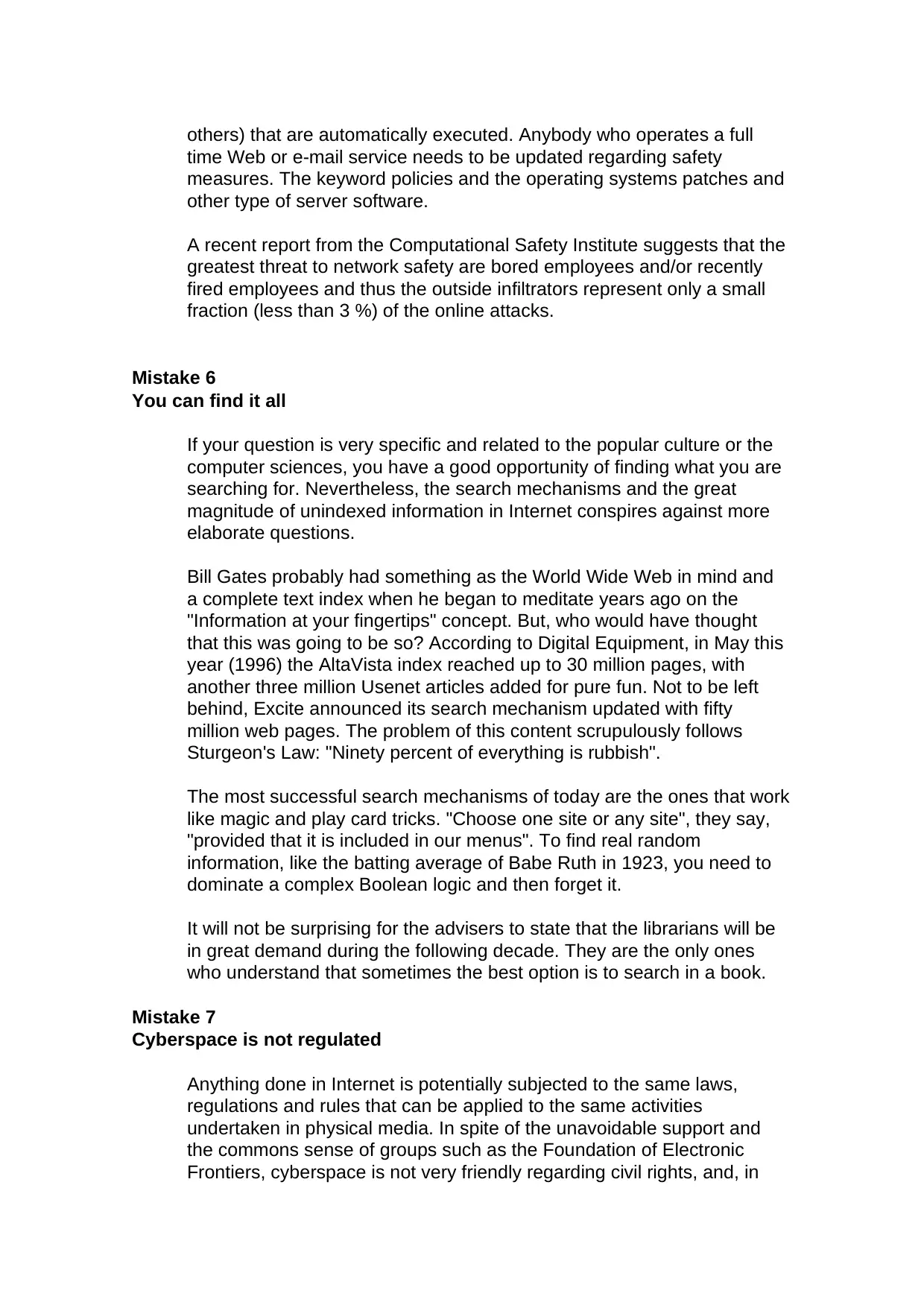
others) that are automatically executed. Anybody who operates a full
time Web or e-mail service needs to be updated regarding safety
measures. The keyword policies and the operating systems patches and
other type of server software.
A recent report from the Computational Safety Institute suggests that the
greatest threat to network safety are bored employees and/or recently
fired employees and thus the outside infiltrators represent only a small
fraction (less than 3 %) of the online attacks.
Mistake 6
You can find it all
If your question is very specific and related to the popular culture or the
computer sciences, you have a good opportunity of finding what you are
searching for. Nevertheless, the search mechanisms and the great
magnitude of unindexed information in Internet conspires against more
elaborate questions.
Bill Gates probably had something as the World Wide Web in mind and
a complete text index when he began to meditate years ago on the
"Information at your fingertips" concept. But, who would have thought
that this was going to be so? According to Digital Equipment, in May this
year (1996) the AltaVista index reached up to 30 million pages, with
another three million Usenet articles added for pure fun. Not to be left
behind, Excite announced its search mechanism updated with fifty
million web pages. The problem of this content scrupulously follows
Sturgeon's Law: "Ninety percent of everything is rubbish".
The most successful search mechanisms of today are the ones that work
like magic and play card tricks. "Choose one site or any site", they say,
"provided that it is included in our menus". To find real random
information, like the batting average of Babe Ruth in 1923, you need to
dominate a complex Boolean logic and then forget it.
It will not be surprising for the advisers to state that the librarians will be
in great demand during the following decade. They are the only ones
who understand that sometimes the best option is to search in a book.
Mistake 7
Cyberspace is not regulated
Anything done in Internet is potentially subjected to the same laws,
regulations and rules that can be applied to the same activities
undertaken in physical media. In spite of the unavoidable support and
the commons sense of groups such as the Foundation of Electronic
Frontiers, cyberspace is not very friendly regarding civil rights, and, in
time Web or e-mail service needs to be updated regarding safety
measures. The keyword policies and the operating systems patches and
other type of server software.
A recent report from the Computational Safety Institute suggests that the
greatest threat to network safety are bored employees and/or recently
fired employees and thus the outside infiltrators represent only a small
fraction (less than 3 %) of the online attacks.
Mistake 6
You can find it all
If your question is very specific and related to the popular culture or the
computer sciences, you have a good opportunity of finding what you are
searching for. Nevertheless, the search mechanisms and the great
magnitude of unindexed information in Internet conspires against more
elaborate questions.
Bill Gates probably had something as the World Wide Web in mind and
a complete text index when he began to meditate years ago on the
"Information at your fingertips" concept. But, who would have thought
that this was going to be so? According to Digital Equipment, in May this
year (1996) the AltaVista index reached up to 30 million pages, with
another three million Usenet articles added for pure fun. Not to be left
behind, Excite announced its search mechanism updated with fifty
million web pages. The problem of this content scrupulously follows
Sturgeon's Law: "Ninety percent of everything is rubbish".
The most successful search mechanisms of today are the ones that work
like magic and play card tricks. "Choose one site or any site", they say,
"provided that it is included in our menus". To find real random
information, like the batting average of Babe Ruth in 1923, you need to
dominate a complex Boolean logic and then forget it.
It will not be surprising for the advisers to state that the librarians will be
in great demand during the following decade. They are the only ones
who understand that sometimes the best option is to search in a book.
Mistake 7
Cyberspace is not regulated
Anything done in Internet is potentially subjected to the same laws,
regulations and rules that can be applied to the same activities
undertaken in physical media. In spite of the unavoidable support and
the commons sense of groups such as the Foundation of Electronic
Frontiers, cyberspace is not very friendly regarding civil rights, and, in
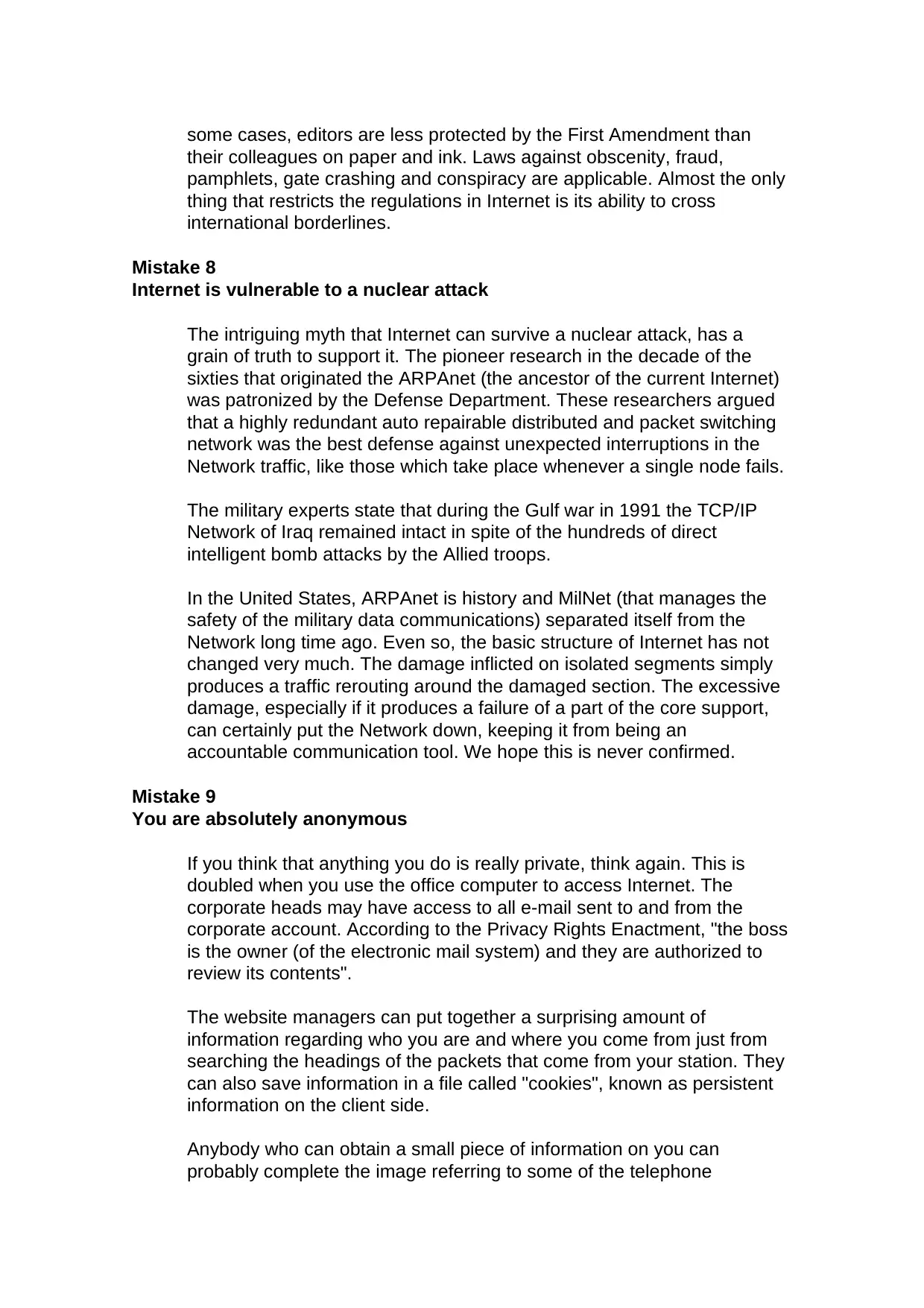
some cases, editors are less protected by the First Amendment than
their colleagues on paper and ink. Laws against obscenity, fraud,
pamphlets, gate crashing and conspiracy are applicable. Almost the only
thing that restricts the regulations in Internet is its ability to cross
international borderlines.
Mistake 8
Internet is vulnerable to a nuclear attack
The intriguing myth that Internet can survive a nuclear attack, has a
grain of truth to support it. The pioneer research in the decade of the
sixties that originated the ARPAnet (the ancestor of the current Internet)
was patronized by the Defense Department. These researchers argued
that a highly redundant auto repairable distributed and packet switching
network was the best defense against unexpected interruptions in the
Network traffic, like those which take place whenever a single node fails.
The military experts state that during the Gulf war in 1991 the TCP/IP
Network of Iraq remained intact in spite of the hundreds of direct
intelligent bomb attacks by the Allied troops.
In the United States, ARPAnet is history and MilNet (that manages the
safety of the military data communications) separated itself from the
Network long time ago. Even so, the basic structure of Internet has not
changed very much. The damage inflicted on isolated segments simply
produces a traffic rerouting around the damaged section. The excessive
damage, especially if it produces a failure of a part of the core support,
can certainly put the Network down, keeping it from being an
accountable communication tool. We hope this is never confirmed.
Mistake 9
You are absolutely anonymous
If you think that anything you do is really private, think again. This is
doubled when you use the office computer to access Internet. The
corporate heads may have access to all e-mail sent to and from the
corporate account. According to the Privacy Rights Enactment, "the boss
is the owner (of the electronic mail system) and they are authorized to
review its contents".
The website managers can put together a surprising amount of
information regarding who you are and where you come from just from
searching the headings of the packets that come from your station. They
can also save information in a file called "cookies", known as persistent
information on the client side.
Anybody who can obtain a small piece of information on you can
probably complete the image referring to some of the telephone
their colleagues on paper and ink. Laws against obscenity, fraud,
pamphlets, gate crashing and conspiracy are applicable. Almost the only
thing that restricts the regulations in Internet is its ability to cross
international borderlines.
Mistake 8
Internet is vulnerable to a nuclear attack
The intriguing myth that Internet can survive a nuclear attack, has a
grain of truth to support it. The pioneer research in the decade of the
sixties that originated the ARPAnet (the ancestor of the current Internet)
was patronized by the Defense Department. These researchers argued
that a highly redundant auto repairable distributed and packet switching
network was the best defense against unexpected interruptions in the
Network traffic, like those which take place whenever a single node fails.
The military experts state that during the Gulf war in 1991 the TCP/IP
Network of Iraq remained intact in spite of the hundreds of direct
intelligent bomb attacks by the Allied troops.
In the United States, ARPAnet is history and MilNet (that manages the
safety of the military data communications) separated itself from the
Network long time ago. Even so, the basic structure of Internet has not
changed very much. The damage inflicted on isolated segments simply
produces a traffic rerouting around the damaged section. The excessive
damage, especially if it produces a failure of a part of the core support,
can certainly put the Network down, keeping it from being an
accountable communication tool. We hope this is never confirmed.
Mistake 9
You are absolutely anonymous
If you think that anything you do is really private, think again. This is
doubled when you use the office computer to access Internet. The
corporate heads may have access to all e-mail sent to and from the
corporate account. According to the Privacy Rights Enactment, "the boss
is the owner (of the electronic mail system) and they are authorized to
review its contents".
The website managers can put together a surprising amount of
information regarding who you are and where you come from just from
searching the headings of the packets that come from your station. They
can also save information in a file called "cookies", known as persistent
information on the client side.
Anybody who can obtain a small piece of information on you can
probably complete the image referring to some of the telephone
⊘ This is a preview!⊘
Do you want full access?
Subscribe today to unlock all pages.

Trusted by 1+ million students worldwide
1 out of 41
Related Documents
Your All-in-One AI-Powered Toolkit for Academic Success.
+13062052269
info@desklib.com
Available 24*7 on WhatsApp / Email
![[object Object]](/_next/static/media/star-bottom.7253800d.svg)
Unlock your academic potential
Copyright © 2020–2025 A2Z Services. All Rights Reserved. Developed and managed by ZUCOL.





